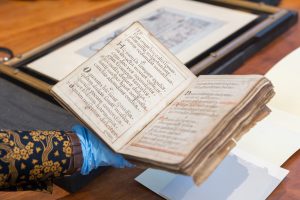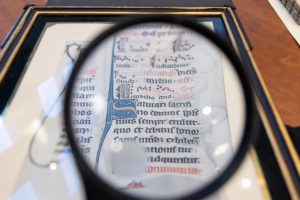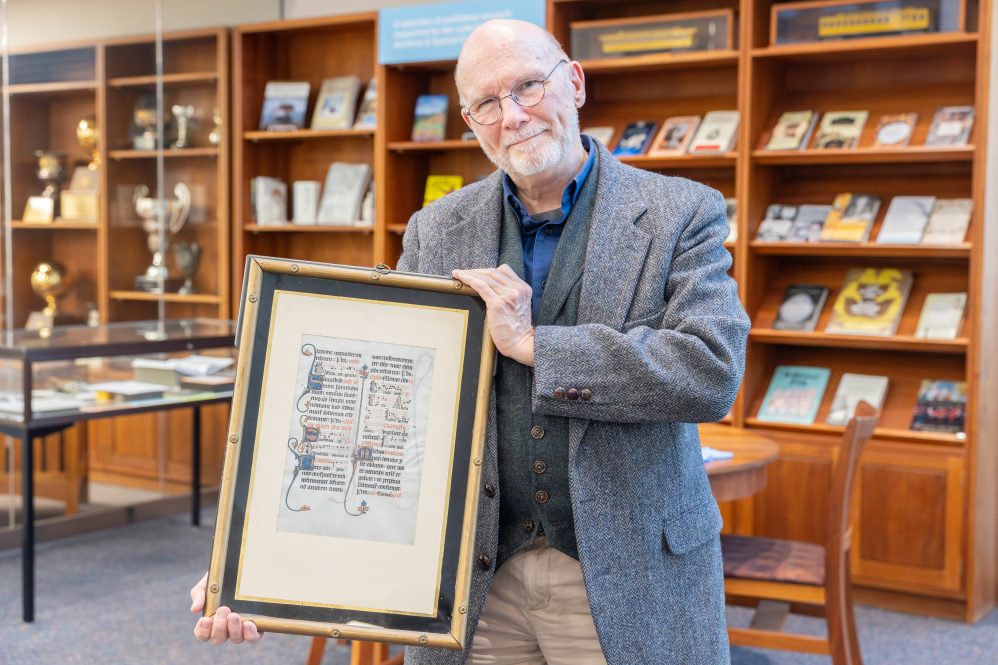Unlike other trinkets one might pick up at an antiques sale, Mansfield resident Thomas Long knew the find he made in the late 1990s was one he probably should shield from the light of day.
In a windowless hallway, situated on top of a bookcase and propped against the wall, it sat in darkness most of the time, save the few instances each year when he’d carefully pack it to bring to class and use as an example of literacy, calligraphy, and literature from the Middle Ages.
Long, a professor emeritus who taught writing in UConn’s School of Nursing, says he’d pass around his framed medieval folio, telling students to admire both sides of the 700-plus-year-old page through the glass that encapsulates it.
“From the first time I saw this beauty, I knew it was a genuine manuscript page because it’s dual-sided,” Long says. “There are irregularities on the surface that indicate it’s lambskin vellum, and the precision of the lettering, the fine decorative marginalia, and the capital letters all tell us this was part of a high-status book.”
He could read enough Latin and had enough life experience to deduce it was part of a Catholic service book. But until just over a year ago, he had no idea he’d been keeper of a page from the Beauvais Missal and inadvertently become part of its storied history that now also includes UConn’s Archives & Special Collections.
In Europe for centuries, brought to America in the 1920s
The story of the Beauvais Missal starts around 1290 when scribes began handwriting its three volumes, one for each of the liturgical seasons of the year, says Lisa Fagin Davis, executive director of the Medieval Academy of America. Upon their completion and the death of the Frenchman who commissioned their writing, they were given to the Beauvais Cathedral in Beauvais, France, in 1356.

For the next 450 years, Catholic priests flipped their pages as they led services from the Octave of Epiphany in January to the Feast of Saint Anne in July and All Saints Day in November. Missals are still used today and essentially provide the order of service.
When the French Revolution upended France, Huguenots stole the Beauvais Missal from the cathedral, Fagin Davis says, and it disappeared from all historical records. A single volume, though, resurfaced in a personal collection in France many decades later.
It changed hands several times before winding up at auction in the United States in 1926.
American businessman William Randolph Hearst – credited with founding the largest newspaper chain in the country, which still operates today – bought the bound volume and kept it until October 1942 when he sold it for $1,000 to New Yorker Philip Duschnes, Fagin Davis says.
Together, Duschnes and friend Otto Ege of Cleveland, Ohio, separated the pages from the book, selling them individually for $25 to $40 and earning a 10-fold higher profit margin with 300 transactions than a single sale.
“There are hundreds of thousands of medieval manuscripts that exist in the world and many of them are much more elaborate and valuable than the leaves of the Beauvais Missal – but the Beauvais Missal is important because of its story,” Fagin Davis says. “It has become one of the most well-known examples of a manuscript that was cut up and scattered to the winds.”
Over the last decade, Fagin Davis has tracked down 122 of 300 pages of the Beauvais Missal to digitally restore the book. She says that while she’s found just shy of half the full volume, that’s still a fair number of pages.
“Every time we find another, we get more information about liturgical practices, musical practices, book history, and art history of the time,” she says. “Once we can start putting all of these leaves together and study them as a unit, we can draw some conclusions about the original object and its story.”
‘There are manuscripts that are splendid’
The story of Long’s part in all this starts about 50 years ago, when at the Catholic University of America he developed an interest in medieval studies that continued through his undergraduate years and into his graduate time at the University of Illinois.
Even after he returned to the Catholic University of America’s seminary school and was ordained in 1980, he says, “Part of my heart was still in medieval studies, which is not a romantic idea but the notion that in many ways our modern world is grounded in cultural and intellectual ideas that emerged or were formed between 500 and 1500 of the Common Era.”
During his eight years in the priesthood, Long was involved in LGBTQ ministry and worked with people suffering and dying from AIDS, the disease that became a household word in the 1980s. He left church leadership in 1988 and returned to academia in pursuit of his Ph.D., which looked at AIDS and American apocalypticism.
“Over the years, I continued reading and studying the medieval period and every once in a while, when I had an opportunity to buy a manuscript folia relief, I would do so,” he says. “And one day, in the late 1990s, at an antiques show in Virginia Beach, I came across the stall of an antiques dealer where I saw this beauty, what we now know is a page from the Beauvais Missal.
“There are manuscripts that are just kind of serviceable, and then there are manuscripts that are splendid,” Long continues, gesturing to the gold leaf, black scrollwork, and deep blue markings– likely from powdered lapis lazuli – decorating his Beauvais Missal page.
For about 20 years until his retirement, he used the page to help teach.
In late summer 2022, just after he retired, Long saw a news story that circulated around the country telling the tale of a Colby College student who discovered a page from the Beauvais Missal at an estate sale in Maine. He says he chuckled and thought that’s every scholar’s dream, how wonderful for a young person.
“Then something nudged me to look at mine again, and I thought, wait a minute. The lettering. The decoration. The coloring. The fact that this was clearly a ritual service book. I wonder if this is another leaf of the Beauvais Missal,” he says.
Before drawing the conclusion, Long first contacted the Beinecke Rare Book and Manuscript Library at Yale University, which has two authenticated pages, to make sure his was the right size. It was – 290 by 240 mm, or roughly 11.42 by 9.45 inches.
Then he contacted Fagin Davis for confirmation. She gave it.
“I knew I had something that was not only unusual, but also extremely valuable. One leaf at auction can fetch $4,000 to $6,000,” he says, adding that he’d purchased his for less than $150. “I knew I needed to put this somewhere safe. Beautiful and rare things should be in public collections, not in private hands.”

UConn in rare company; 1 of 9 in New England
The story of UConn’s Archives & Special Collections’ involvement starts here, with Long’s donation about a year ago of the now authenticated Beauvais Missal folio along with numerous other historical artifacts he’s collected along the way.
“As an agricultural college, the University in its early years didn’t collect rare objects like this for teaching, but students today need to be exposed to original works,” Melissa Batt, an archivist at the library, explains. “We use specimens like this in our instruction, programming, and exhibitions. This donation allows us to expose students to original materials even if they come with this story of being disbound.”
Fagin Davis says UConn’s acquisition puts the University in good company, as one of only nine schools in New England to have pages in their collections: UMass Amherst, the Rhode Island School of Design, Harvard and Yale universities, and Smith, Wellesley, Dartmouth, and Colby colleges. The Wadsworth Atheneum in Hartford and the Boston Public Library also have pages.
Without an endowment to purchase such items and with restrictions on how things can be bought, Batt says donations like the one from Long are key to helping UConn’s Archives meet its mission.
And in this case, students studying the history of print, the interplay of image and text, among so many other broader subjects, can benefit from seeing the page – due to its fragility, access to the leaf requires special handling by an archivist.
UConn’s Beauvais Missal folio features service entries for the feasts of St. Callixtus and St. Lucian and looks pristine despite its age, with its black ink still dark as night, because, Long says, their pages would have been opened only once a year and only at an altar, through the filtered light of stained glass and away from damaging direct sunlight.
Both the words and musical prompts – black notes on red staffs – would have been for the priest as leader of the service; the choir would have offered its response from an antiphonal, a much larger book shared between several people, Long says.
The 122 pages that have been found are from the same volume, Fagin Davis says, because they’re service pages for the summer feasts, Easter through Advent.
But the Beauvais Missal’s author is anonymous.
“They believed the word of God was literally translated through their hands and onto the page, although the scrolls, the ornamentation, even how the capitals are formed serve as a sort of signature,” Batt says. “Still, the writer was meant to be anonymous because scribes weren’t allowed to be vain in any sense. They were a vessel through which God speaks.”
The Beauvais Missal is written in an abbreviated Latin that, Long says, was developed by monks to conserve expensive parchment. Reading it in gothic script might be a challenge, especially for words with a string of similar letters – like the u, m, and n in communium- but individual words can be discerned.
Hallelujah. God. Lord. Holy. Sacrifice. Almighty.
“If you are interested in the European Middle Ages and you live on our side of the Atlantic, you can’t study that time period by looking at the things around you,” Fagin Davis says. “People in Europe walk by medieval buildings every day. For us, being able to see a medieval manuscript like the Beauvais Missal is a magical entryway to thinking about the Middle Ages.”



